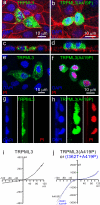The varitint-waddler (Va) deafness mutation in TRPML3 generates constitutive, inward rectifying currents and causes cell degeneration
- PMID: 18162548
- PMCID: PMC2224216
- DOI: 10.1073/pnas.0707963105
The varitint-waddler (Va) deafness mutation in TRPML3 generates constitutive, inward rectifying currents and causes cell degeneration
Abstract
Varitint-waddler (Va and Va(J)) mice are deaf and have vestibular impairment, with inner ear defects that include the degeneration and loss of sensory hair cells. The semidominant Va mutation results in an alanine-to-proline substitution at residue 419 (A419P) of the presumed ion channel TRPML3. Another allele, Va(J), has the A419P mutation in addition to an I362T mutation. We found that hair cells, marginal cells of stria vascularis, and other cells lining the cochlear and vestibular endolymphatic compartments express TRPML3. When heterologously expressed in LLC-PK1-CL4 epithelial cells, a culture model for hair cells, TRPML3 accumulated in lysosomes and in espin-enlarged microvilli that resemble stereocilia. We also demonstrated that wild-type TRPML3 forms channels that are blocked by Gd(3+), have a conductance of 50-70 pS and, like many other TRP channels, open at very positive potentials and thus rectify outwardly. In addition to this outward current, TRPML3(419P) and (I362T+A419P) generated a constitutive inwardly rectifying current that suggests a sensitivity to hyperpolarizing negative potentials and that depolarized the cells. Cells expressing TRPML3(A419P) or (I362T+A419P), but not wild-type TRPML3, died and were extruded from the epithelium in a manner reminiscent of degenerating hair cells in Va mice. The increased open probability of TRPML3(A419P) and (I362T+A419P) at physiological potentials likely underlies hair cell degeneration and deafness in Va and Va(J) mice.
Conflict of interest statement
The authors declare no conflict of interest.
Figures





Similar articles
-
TRPML3 mutations cause impaired mechano-electrical transduction and depolarization by an inward-rectifier cation current in auditory hair cells of varitint-waddler mice.J Physiol. 2008 Nov 15;586(22):5403-18. doi: 10.1113/jphysiol.2008.156992. Epub 2008 Sep 18. J Physiol. 2008. PMID: 18801844 Free PMC article.
-
The varitint-waddler mouse phenotypes and the TRPML3 ion channel mutation: cause and consequence.Pflugers Arch. 2008 Nov;457(2):463-73. doi: 10.1007/s00424-008-0523-4. Epub 2008 May 27. Pflugers Arch. 2008. PMID: 18504603 Review.
-
A helix-breaking mutation in TRPML3 leads to constitutive activity underlying deafness in the varitint-waddler mouse.Proc Natl Acad Sci U S A. 2007 Dec 4;104(49):19583-8. doi: 10.1073/pnas.0709846104. Epub 2007 Nov 28. Proc Natl Acad Sci U S A. 2007. PMID: 18048323 Free PMC article.
-
Gain-of-function mutation in TRPML3 causes the mouse Varitint-Waddler phenotype.J Biol Chem. 2007 Dec 14;282(50):36138-42. doi: 10.1074/jbc.C700190200. Epub 2007 Oct 25. J Biol Chem. 2007. PMID: 17962195
-
TRPML3 and hearing loss in the varitint-waddler mouse.Biochim Biophys Acta. 2007 Aug;1772(8):1028-31. doi: 10.1016/j.bbadis.2007.01.007. Epub 2007 Jan 23. Biochim Biophys Acta. 2007. PMID: 17329082 Review.
Cited by
-
Expression and vesicular localization of mouse Trpml3 in stria vascularis, hair cells, and vomeronasal and olfactory receptor neurons.J Comp Neurol. 2011 Apr 15;519(6):1095-1114. doi: 10.1002/cne.22554. J Comp Neurol. 2011. PMID: 21344404 Free PMC article.
-
The intracellular Ca²⁺ channels of membrane traffic.Channels (Austin). 2012 Sep-Oct;6(5):344-51. doi: 10.4161/chan.21723. Epub 2012 Aug 21. Channels (Austin). 2012. PMID: 22907062 Free PMC article. Review.
-
Permeation properties of the hair cell mechanotransducer channel provide insight into its molecular structure.J Neurophysiol. 2012 May;107(9):2408-20. doi: 10.1152/jn.01178.2011. Epub 2012 Feb 8. J Neurophysiol. 2012. PMID: 22323630 Free PMC article.
-
Heteromultimeric TRPML channel assemblies play a crucial role in the regulation of cell viability models and starvation-induced autophagy.J Cell Sci. 2010 Sep 15;123(Pt 18):3112-24. doi: 10.1242/jcs.067330. Epub 2010 Aug 24. J Cell Sci. 2010. PMID: 20736310 Free PMC article.
-
Yoda1-induced phosphorylation of Akt and ERK1/2 does not require Piezo1 activation.Biochem Biophys Res Commun. 2018 Feb 26;497(1):220-225. doi: 10.1016/j.bbrc.2018.02.058. Epub 2018 Feb 8. Biochem Biophys Res Commun. 2018. PMID: 29428723 Free PMC article.
References
Publication types
MeSH terms
Substances
Grants and funding
LinkOut - more resources
Full Text Sources
Molecular Biology Databases

